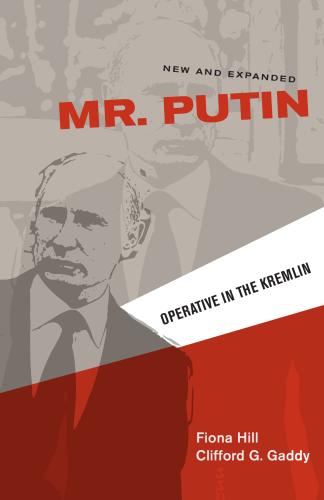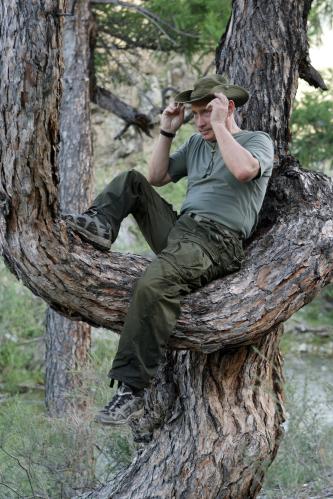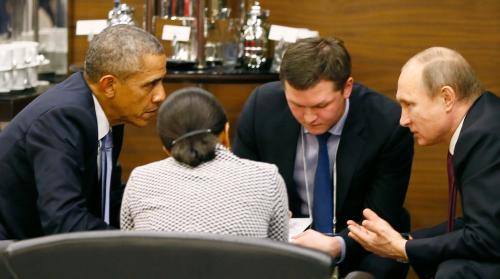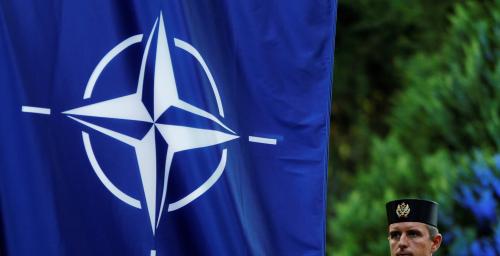This piece is part of a series remembering the life, career, and legacy of Helmut (Hal) Sonnenfeldt — a member of the National Security Council, counselor at the Department of State, scholar at the Johns Hopkins School of Advanced International Studies (SAIS), and Brookings expert.
Where is Russia headed, now that it has regained some of its economic power and political confidence (despite the country’s recent economic troubles) that was shattered at the end of the Cold War? Hal Sonnenfeldt’s sense of history and his understanding of political culture, as well as national security narratives in different countries, would surely counsel us to consider this question. For the foreseeable future, at least another half decade, this question will be largely indistinguishable from the personal proclivities of Russian President Vladimir Putin, who is expected to remain president until 2024. But it is also useful to try to understand the broader Russian strategic culture in which he operates. This will be crucial for long-term U.S. strategic planning — and for setting realistic expectations about what we can anticipate, and work toward, in the Western relationship with the Russian Federation. The below draws on work we did several years ago, but remains relevant today. The Russia of 2019 is not much different from that of 2014 and 2015, and of course it still has the same leader. But where might things be headed, longer-term? For analytical purposes, we propose five distinct models of possible future Russian grand strategy:
- Pro-Western Russia. With this model, Russia would not join NATO but might associate more closely with the West in other types of security arrangements, such as a strengthened Organization for Security and Co-operation in Europe (OSCE) or a new type of Euro-Atlantic security community.
- Minimalist Russia. A minimalist Russia might not have the pro-Western outlook of the above possible strategies, but could still conclude that its own interests dictated a modest and restrained security policy as the state sought to maximize power through economic strength — with nuclear weapons constituting the main, relatively inexpensive linchpin of national military strategy.
- “Reaganov” Russia. A Reaganov Russia would be highly patriotic and engage in military buildups and perhaps a certain degree of nationalist rhetoric, with a central goal of reasserting traditional forms of state power — but with the twin goal of not employing that military power unless absolutely necessary. Just as Ronald Reagan re-armed the United States and gave the country a boost of confidence at home and on the world stage, with increased defense spending also providing at least a temporary economic lift, this vision for Russia would seek to establish and advertise Russian power without frequently sending forces into combat.
- Besieged Russia. This concept for the country’s future would be akin to the Reaganov model, but focus less on patriotism or prestige and more on settling scores with enemies and adversaries, both real and perceived. Its means might be covert and coercive as much as violent, but it would not be a particularly friendly nation. It might be a less confident, less forthright, more devious, and in some ways more dangerous Russia than the possible Reaganov type. It is perhaps not unlike Russia under Putin since 2014.
- Greater Russia. This paradigm would continue in the same Reaganov spirit but go even further. It would seek specific opportunities to employ state power to reconstruct part of a greater Russian empire and demand a certain amount of influence with neighboring states — a Russian sphere of influence in a more classic, hard-power sense, akin to aspects of tsarist times. This might logically extend to lands where Russian speakers are in a majority, as with the eastern parts of Ukraine and the Baltic states. It could extend to sea as well, notably in the Arctic region. It might be thought of as “worst-case Putin.”
Pro-Western Russia
Even if it is unimaginable that a future Russia would seek to join NATO — whether or not NATO would have it as a member, itself an unlikely proposition — it is not beyond belief that a post-Putin Russian state could look to mend fences and develop fundamentally compatible interests with the Western world, even as it remained somewhat aloof and separate. Several motivations could drive Russians toward such an outcome. Russia could seek to maximize its interactions with the outside world largely for the sake of economic growth and prosperity. It could also see a strong association with the European Union or North Atlantic Treaty Organization (NATO) as a useful hedge against Islamist extremism and China’s rise. Put differently, to reach this mindset, Russia would not necessarily have to abandon all security fears, real or imagined, but would have to conclude that the greater dangers came from the south or east (or within) and could be more effectively checked with Western help. It would reflect a decision that may seem obviously correct to Western observers but is much harder at present for Russians, given the common view that NATO broke its word and took advantage of their weakness after the Cold War.
NATO expansion may someday be a more distant memory. If the Western world in conjunction with Russia can find a solution to ensuring Ukrainian and Georgian security (and that of other former Soviet republics not currently in the Western alliance) without offering NATO membership to them, it is possible that future generations of Russians will be able to declare a truce in this geostrategic competition (as many Americans probably assumed they already had, prior to the events of 2014) and move beyond it. Time may heal some wounds.
The essence of this kind of policy would be a return to the calmer days of NATO–Russian relations of the 1990s or the early Putin years — yet in the context of a confident and stable Russia. This dynamic could create new institutional mechanisms, or continue existing vehicles such as the OSCE, NATO-Russia council, and U.N. Security Council (as well as a possible Russian return to what is now the G-7). Nuclear arms control might resume, missile defense negotiations could become less acrimonious, and strategic cooperation on issues like Iran, North Korea, and Afghanistan could outweigh disputes over any ongoing problems like Syria. The blocs might cooperate on peacekeeping missions and would presumably strengthen counterterrorism cooperation as well.
Minimalist Russia
A “minimalist Russia” might not be so pro-West. And yet, it might still wind up fairly benign in the international arena. If it concluded that it was not likely to be attacked or otherwise threatened, it could perhaps get by with a modest-sized army, navy, and defense budget, coupled with a substantial nuclear arsenal (something that seems a given under any plausible future scenario).
This Russian strategic outlook might receive momentum first and foremost from economic policy technocrats and business elites. The pragmatic emphasis would be on developing a competitive economy and improving the Russian quality of life — and, ultimately though implicitly, Russian national power as well. Russia would not act as a giant Switzerland in attitude or outlook. But it could resemble one in its military restraint, largely out of self-interest — however unlikely that might seem at present.
The belief that Russian security was threatened less by foreign foes and more by internal challenges could help motivate this paradigm. Since the National Security Strategy for Russia of 2009 emphasized the importance of everything from economics to healthcare to the environment in its list of national security priorities, there is a predicate in modern Russian thought for leavening the importance given to more traditional measures of power and security.
Reaganov Russia
What might be termed a “Reaganov Russia” would represent a proud, nationalistic state that in the Russian context might strike many as aggressively motivated and inclined. But if in fact the Russian state could take pride in reestablishing itself as a successful status-quo power, it might not see the need for revanchism or other aggression — at least not on a large scale. It could pragmatically weigh its own interests across a wide range of policy options, often concluding that it should cooperate with the West on key strategic issues for its own well-being. Freed by greater self-confidence and pride from the kind of anger and pettiness that might come with the besieged Russia discussed below or that we have seen recently, it could make clear-minded and good decisions on matters where the West really needed its help — and about which there was no rational reason for a divergence of positions between Moscow and Western capitals.
Our use of the “Reaganov” label is not intended as a commentary on Ronald Reagan’s overall legacy in the United States. Our point is merely that if one reduces Reagan foreign policy to its component parts — a strong military, but rarely used; a confident United States that struck some as arrogant, but which was led by a generally affable leader and that became collectively more comfortable in its skin as the decade progressed; and an economically successful nation with strong industries in various key strategic sectors — that could offer an analogy to a future Russia. If it channeled its patriotism into relatively benign actions like improving its armed forces and advancing in economic and scientific realms, the effect of such a Russia on the region and the world could be relatively innocuous.
This framework for the future Russian state might envision the defense sector providing technological innovations which could spin off to revive the Russian scientific and manufacturing sectors more broadly. The idea is Reaganesque in the U.S. tradition (though spinoffs from the defense world were perhaps even more notable in the United States in the decades just before Reagan). But it is also an idea advanced by defense official Dmitry Rogozin in today’s Russia.
Besieged Russia
We perhaps need to say the least about this possible future path for Russia because it may most resemble the current mindset of President Putin. The notion here is that the wounds to Russian pride may be even deeper, and bitterness even more entrenched, than many have appreciated. Particularly if Vladimir Putin is able to get away with additional adventures in Ukraine, and if Russian economic growth does not suffer unduly, Russian voters and strategists may decide that there is room to make further mischief in the near abroad for many years to come. It could feel besieged itself — and seek to make others, especially smaller neighbors, feel the same way.
By this vision, Russia would not relent, even though it could make various tactical adjustments and show restraint when temporarily expedient. It could at some future time pursue opportunities for expansion or at least seek to reestablish a strong sphere of influence in much of Ukraine, Belarus, Moldova, and Georgia, while pursuing potentially hostile policies toward the Baltic states and perhaps Poland and other Central European states. The facts that Vladimir Putin may remain in office a full decade more, and perhaps also shape the selection of his successor, provide further grounds for believing that we cannot easily dismiss this model of a future Russia.
It is also possible that latter-day notions of a great-power Russia could reinforce this mindset. Harkening back to traditions of Russian thought that glorify its role as the great Slav nation, the heart of Eurasia, the bridge between East and West — this kind of Russia could be inspired by pride as well. It would build on the traditions of earlier Russian leaders like Peter the Great and Alexander II, and the thinking of intellectuals such as Alexander Dugin, Eduard Limonov, and Elgiz Pozdnyakov.
Such a worldview would not look fundamentally unlike what we describe in the Reaganov vision of the country. But it could be less benign in this case, as it would be intertwined with a sense of aggrievement. Dmitri Trenin describes this outlook as “post-imperialist” rather than imperialist or neo-imperialist, still quite assertive in goals even if different from traditional forms of great-power behavior in the means employed. Militarily, its signature behavior might be exemplified by the special operators in unmarked outfits in Crimea in early 2014 — the “little green men” — in contrast to the classic infantry or tank invasion forces of earlier epochs.
Greater Russia
This concept takes the idea of a besieged Russia one step further. It postulates a Russian state that seeks not only to gain revenge and restore dominance over near-abroad states but to maximize national power in the traditional, imperialist sense more generally.
This could imply even more blatant and aggressive actions against the former Soviet republics in Europe. It could further include Russian expansionism into the Central Asian republics, where there are some significant ethnic Russian populations that could provide a Putin-like leader with pretexts for aggression. It could also feature greater use of Russian naval power in the state’s exclusive economic zones and beyond, to extract economic benefits through means such as mineral and hydrocarbon exploitation, extensive fishing, and dominance of Arctic shipping lanes as they open up due to global warming. (Indeed, some of this is happening already under Putin, with the September 2013 occupation of the New Siberian Islands in the northern regions above Russia, and increased military maneuvers in northern seas as well.)
This type of worldview and competitive international approach could also include further efforts to impede international collaboration on projects of importance to the West such as nonproliferation efforts against Iran and North Korea.
In light of all the above, which scenarios are most likely for future Russian policy, especially projecting out beyond the Putin years?
A Russia that might seek to join NATO, or that might reflect a post-Westphalian outlook toward the nation-state, seems a very remote possibility at best. That type of outcome reflects a liberal worldview that has fewer adherents than ever, perhaps, within Russia today, and the trend seems due to far more than just President Putin. On the other extreme, an expansionist Russia echoing elements of Brezhnev’s Soviet Union offers far too little benefit for the likely costs and risks.
As for the remaining options — a pro-Western Russia, a minimalist Russia, a Reaganov Russia, a besieged Russia, or a greater Russia — it is harder to be so confident about which will weigh most heavily in the federation’s future strategic culture. But a genuinely pro-Western state seems increasingly a remote possibility, certainly for the relatively near future, given the rallying around Putin since 2014. A minimalist Russian national security strategy seems a likely outcome only if Russia, a proud and ambitious nation, decides to seek status and respect through excellence in economic and other nonmilitary spheres, rather than risk self-destruction through excessive militarization. A greater Russia would cut itself off from the world, through even deeper economic sanctions than have been imposed since the Ukraine crisis of 2014, and seems rather remote as a prospect, even if not entirely out of the question.
As such, our money is on the remaining two options: 1) a state whose foreign and security policy outlook resembles a Reagan-era United States, characterized by a high degree of patriotism, a degree of favoritism for the nation’s armed forces in national policymaking , and yet restraint in the actual use of military force as an instrument of foreign policy; and 2) a besieged Russia that generalizes and sustains the kind of approach to foreign policy showcased by Vladimir Putin in 2008 and again since 2014, opportunistically rather than as part of a consistent strategy of neo-imperialism (as a greater Russia model might imply).
Of these two options, the Reaganov option — while it may not lead to a lower level of military spending — is in fact more benign. It implies a more self-confident and self-satisfied, and therefore less truculent, outlook toward the world by Moscow. It suggests a national outlook that would seek to calculate its interests abroad rationally and reasonably, and make decisions accordingly.
This could be good news, and a desirable result, for Washington. The West and Russia would appear, in objective terms, to share most global interests on matters ranging from nuclear nonproliferation to counterterrorism to shaping China’s rise in benign ways. Thus, a Russian strategic perspective that cleared away emotional baggage and allowed a relatively clear-eyed assessment of when and where to cooperate with outside powers should produce a Russia that was easier to deal with. If highly sensitive issues like NATO expansion and missile defense could be managed, this could lead to a world in which the Russian state retained a distinctly different character than Western nations — and one that seemed off-putting and somewhat unappealing to many liberal perspectives — but one too with which core interests could be mutually pursued. It may just be the best we can hope for. We are guessing it may be what Hal would have counseled to be the best we could hope for, as well.
The Brookings Institution is committed to quality, independence, and impact.
We are supported by a diverse array of funders. In line with our values and policies, each Brookings publication represents the sole views of its author(s).











Commentary
Towards a “Reaganov Russia”: A realist view influenced by Hal Sonnenfeldt
October 17, 2019